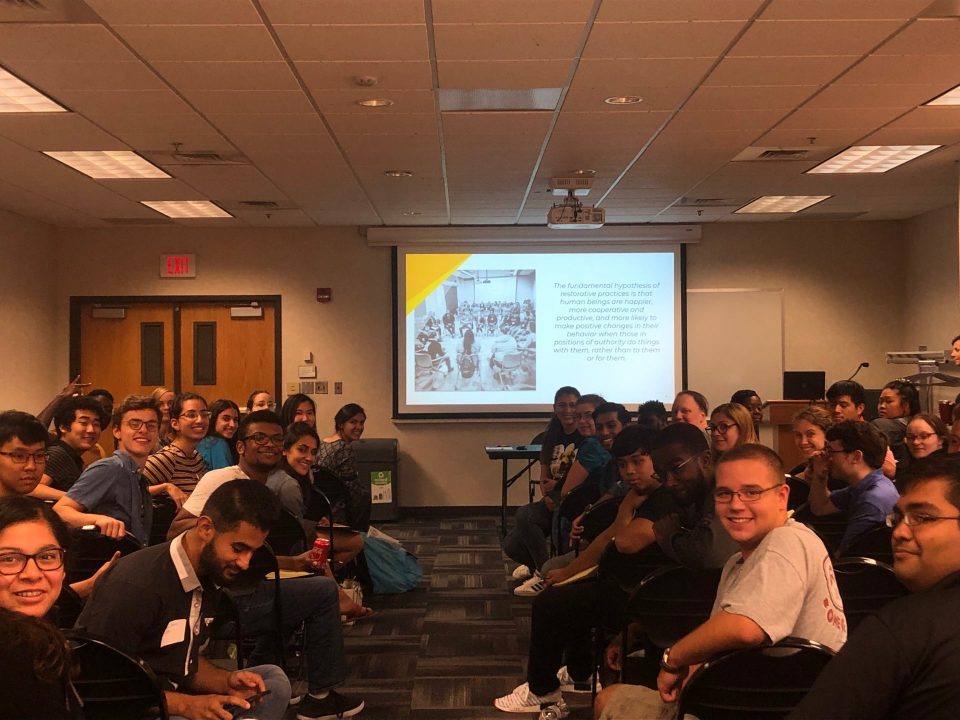Lauren Mauriello begins her meetings by setting community standards.
The Assistant Director of Student Conduct opened her workshops at LeadingOrgs, a mandatory student organization leadership training, by asking what method was best for gathering everyone’s attention in the almost full University Center classroom. She uses restorative practices, a tool that emphasizes building relationships between people, repairing harm and rebuilding trust when harm occurs.
“Everybody on the campus has to be thinking in a restorative way for it to really make a difference,” Mauriello said.
Restorative practices were first introduced to the University of Maryland, Baltimore County in 2011 when the department of Student Conduct and Community Standards first began talking about implementing the practice on campus. The department then brought subject matter experts into UMBC to learn how to use restorative practices in student conduct processes, but the idea did not initially stick.
It was not until 2014, when Residential Life partnered with Student Conduct and Community Standards, that the initiative started gaining ground. Now, as Residential Life and other partners work to introduce restorative practices to more groups across campus, they are focused on building the groundwork for community building in less conventional places.
“We’re always looking to expand our reach of restorative practices in the UMBC community,” said Davonya Hall, the Assistant Director of Student Conduct and Community Standards. “We’re also going to focus more on our academic relationships.”
Residential Life and the Student Conduct and Community Standards office already have procedures which use restorative practices, but student organizations, club sports and academic departments may not get the chance to experience and gain from these methods if they do not engage with these other departments.
UMBC hosts about four restorative practice trainings per year, which are meant to give students, faculty, staff and outside leaders the tools to bring these practices into their own communities.
“We really have to make sure we’re reaching students where they’re at,” Mauriello said.
Timmy Farrell, who is now a graduate student at Virginia Tech studying higher education and student affairs, utilized the techniques he learned in these trainings when he was in the National Alliance of Mental Illness, or NAMI. He abandoned the club’s typical presentation-style meeting and instead rearranged the classroom to form a circle, which he said “felt like the right thing to do.”
“This meeting was different because it turned into all of us sitting in a circle talking about how we practiced self-care,” Farrell said. “It brought to the forefront the relationships we had together in NAMI. I wish we did more of those meetings.”
Farrell, in his position as an office assistant for restorative practices and Residential Life, has written a series of blog posts breaking down different aspects of restorative practices and how student organization leaders can incorporate them into their general body meetings and organizational culture.
“As I’ve been introduced to restorative practices, I really embraced it and found it to be extremely useful and beneficial and intuitive to me and how I want to be a leader,” Farrell said.
According to the International Institute for Restorative Practices, restorative practitioners should spend 80 percent of their time building community. At UMBC, Hall and Mauriello said that begins by sharing small. Making sure community members feel heard means they will eventually feel more comfortable speaking up, raising concerns and participating in organizational change.
“We commit to community, and that’s what we’re here to do,” Mauriello said. “The way that we build that community matters.”
Editor’s Note: This article has been updated to represent the departments of people working towards implementing restorative practices on campus, not just the people mentioned in this article. Updated Sept. 11, 2019.
Photo Credit: Students at LeadingOrgs gather for Lauren Mauriello’s session entitled Leading With Your Team: Balancing Accountability and Support. Photo by E.G.



